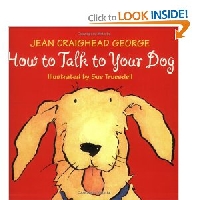How to talk to dogs
By Catalogs Editorial Staff

Knowing how to talk to dogs makes a difference in their response and behavior
Yes, people talk to their pets. No, it’s not crazy. However, there are certain ways an owner can better communicate to and respond to his dog. How to talk to dogs? Let’s find out.
Canine are adroit communicators. They wag tails, paw at their owners, nudge with their heads, snarl, growl, whine and make all kinds of sounds and gesture when they are trying to communicate something.
Animal body language is fascinating and tells us what we need to know about our pets and other creatures.
Obviously, animals don’t literally talk to humans, but humans and animals can effectively communicate if people learn what certain things mean.
Dogs pay attention to their owner’s voice. It is important to pay particular attention not only to what you say but how you are saying it. If you want your canine to chill out, say, “Eaassssy” in a prolonged monotone. Conversely, if you want your pet to hurry up, say, “Go! Go! Go! In a series of staccato, recurring high-pitched tones. If your dog is about to walk out into the street, say “STOP!” in a low-pitched, curt voice.
~
Think about it: When canines are feeling aggressive or territorial they emit a low-pitched growl. If you speak in that same tone when giving a command you are indicating you are in charge. The dog will take notice.
When you want your pet to feel safe, secure and at ease, use a higher pitched tone. People often talk to their canines, particularly to puppies, in the same voice they use to talk to babies. This voice prompts the animal to play and engage with others. This is the owner’s non-dominate or non-threatening voice.
Canines not only pay attention and react to human voices but also to human body language. Looking at a pooch directly in the eye is construed as a threat. Keep that in mind, particularly when dealing with strange dogs. Do not be aggressive. Do not barge up to a canine and expect him to be friendly. You may get nipped.
If you bend down and forward to address a dog, the canine is going to move backward. when hugging a dog realize that to him this is a gesture of dominance. If you tousle his head or give him a swat on the back this is another gesture of dominance.
Tail wagging
Did you know tail wagging to the right means a canine is feeling good about a situation or person? Why would that be? Researchers conclude the right tail wag is the result of the left brain, which is linked to emotions, including affection, relaxation and security and, which controls the right side of the body.
On the other hand, a stiff tail is not a welcome sign. Be wary. The canine may be warning you not to approach.
Other interesting things …
A canine with good self-esteem holds his tail up high whereas an insecure pooch tucks his tail between his legs.
When animals are interested in what’s going on around them, they prick their ears forward or upward. If the animal is fearful, his ears lie back.
Sometimes canines stare, other times their eyes blink. When concentrating, blinking occurs.
When your pooch licks you, this may be more of a sign of respect than affection. Licking is a dog’s way of indicating respect, deference and that he is not threat. Lesser canines lick the Alpha dog or person as a gesture of conciliation.
Pay attention to what you are saying to your pet and how you are saying it. Pay equal attention to his responses.
Popular Savings Offers











